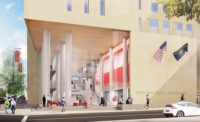After a nearly a half decade with little high-rise construction activity, work began in June 2014 on the Lincoln Square expansion in downtown Bellevue, Wash. The project would push the limits of what a Northwest construction team could accomplish.
Both of the Lincoln Square towers were designed to rise within inches of the city’s 450-ft height limit, and both the 41-story hotel with its residential components and the 32-story office tower sit atop a three-level podium. Other elements include 175,000 sq ft of retail, entertainment and dining space and a six-level below grade parking garage.
General contractor GLY Construction self-performed the largest continuous mat pour in Washington state history in February 2015, breaking a record the firm had set a month earlier on the same project. Both pours approached 14,000 cu yd.
“We’ve had nothing but good relationships with those guys, and we will continue to use them,” says Fritz Walter, director of construction, Kemper Development Co., the owner of Lincoln Square and several other significant developments in Bellevue.
But it wasn’t only the execution of the building plan that impressed Walter. He says GLY Construction was able to fill the gap when architect Sclater and Associates closed shop—with the retirement of its namesake principal in November 2015—allowing the project to remain on a fast-track schedule.
“They not only lived up to that task; they went above and beyond,” Walter says.
The results were not due just to technical and practical expertise but also based upon the philosophy of solid customer service, community building and problem solving, upon which GLY has built its reputation, according to Jim Broadlick, senior director of design and construction for Vulcan, another major Seattle owner and developer who has worked with GLY for nearly a decade.
“What distinguishes GLY is that they always have our best interests at the forefront of what they do,” he says. “It is why we continue to use them in project after project.”
For these reasons and many others, GLY Construction has been selected as the ENR Northwest Contractor of the Year by the regional editors of ENR.
Bellevue Born and Raised
GLY has been building in and around the Bellevue area for nearly 50 years. Named for the two founders of the company, Harold Gall and Robert Landau, and their partner Frank Young, the firm has grown steadily over the past five decades and is the go-to firm in the technologically savvy Northwest. As GLY reported to the ENR Northwest regional contractors survey, the firm had revenue of $569 million in 2015, up from $433 million in 2014, which was, in turn, up approximately $200 million from 2013.
“As a local contractor, we have to have repeat work. We’ve done more than three jobs with most of our clients.”
—Steve Hoffmann, Principal, GLY
GLY employs nearly 600 people and self-performs concrete work, carpentry and layout, general labor and some of the large equipment operations, including tower cranes. Currently, firm ownership is shared among 10 principals, says executive vice president Ted Herb, who oversees operations. Several management transitions have occurred since the firm’s founding, with all owners remaining involved in project delivery, he says.
GLY rarely operates outside of the Puget Sound area and has become adept at a variety of project types.
“As a local contractor, we have to have repeat work. We’ve done more than three jobs with most of our clients,” says Steve Hoffmann, principal at GLY.
Beyond the Lincoln Square project, GLY is expected to begin work next year on a four-building complex for developer Vulcan and its tenant, Google. The six-story buildings will include 607,000 sq ft of office space for Google and 14,000 sq ft of accessory ground-floor retail space for restaurants, shops and other services for Vulcan.
GLY’s work for tech firms in the Puget Sound area is based upon expertise gained during the firm’s rise with the area’s tech boom in the 1990s. Hoffmann says GLY’s work with Microsoft during that time was the main stepping-stone to the firm’s current high-tech portfolio.
He specifically cites work in the late 1990s on building 33, also known as the Microsoft Conference Center, on the software giant’s main campus in Redmond, Wash. Hoffmann says as the task grew from its original parameters, GLY innovated quickly.
“We started to push ourselves in many ways. It forced us to grow our game because we were doing things we hadn’t done before,” he says.
Embracing Technology, Service
Over the last 20 years, the firm has become a technology innovator and embraced integrated project delivery.
“In 1998, we were much more narrowly focused, and the complexity level of the projects we were taking didn’t reach the scale that it currently does,” says Mark Kane, GLY executive vice president, who oversees client services and marketing. “The tools we are putting in place today are really leveraging the technology that is available to us. It is just allowing us to execute a significant level of projects at a higher level of quality and speed.”
The firm adopted Revit and other forms of building information modeling in the early 2000s. Today, all of its project management teams are trained in BIM. Earlier this year, GLY received the AGC Build Washington Excellence in Technology award for its virtual analysis of vertical surfaces during excavation and shoring for the 271,000-sq-ft Allen Institute project.
“Some of the tools like modeling have made us stronger,” Hoffmann says. “Our motto is ‘Think, plan, build.’ We don’t just want some guys in the corner working on this stuff.”
According to Kane, when the team works together in a virtual environment to work out details in a plan, the process creates a truly integrated team. The resulting benefits are higher quality and a better ability to meet more aggressive schedules.
“It is highly cost effective because every step in the field supports the end goal,” Kane says.
He says the integration of BIM has allowed a return to the days when projects were crafted with the help of drafting tools.
“Today that looks like an engineer with a superintendent. One helping communicate the right way to build it and the other documenting it in a manner that includes all of the information. Now, instead of a silo approach, they work together.”
Kane says GLY takes pride not only in work it self-performs, but also in how it makes the firm more attuned to the challenges of it subcontractors.
“Most of our clients in the Northwest really benefit from the fact that there are still contractors that focus and specialize in being really good builders and still have the ability to execute work at the highest level,” Kane says.
Herb says staying on the leading edge of construction technology means an ongoing commitment to training and education.
“One of the key values of our company is continuous improvement, and we recognize there are things we can’t control. But one of the things we can [control] is our brain,” he says.
Safety is another key company value. According to Herb, a safe jobsite is of paramount importance in order to attract new business and maintain support from the workforce.
“It’s a struggle to not forget that you are on a dangerous environment all day and every day, especially with pressure to meet schedules, but safety is still the most important thing,” he says.
The firm’s current EMR is 0.4577 for more than 1 million hours worked. GLY has also maintained an average 0.53 rating over the last 16 years. A safety committee reviews every incident and addresses the root cause and provides updates to the project teams. Further, he says foremen receive regular safety statistic updates to stay up-to-date on company-wide performance.
“We like to reinforce good behavior instead of punishing people if they have bad behavior. That’s not our culture,” Herb says.
The firm also engages within its home community of Bellevue and the Puget Sound region in a similar inclusive fashion.
“We all benefit from a thriving community at multiple levels. For this to be sustainable, we need to invest in every level of our community, and we need everybody to be prospering. We need to be sure we give back to those needing our support,” says Kane.
Although the list is long, two notable beneficiaries of the firm in the community are the Washington state chapter of the Alzheimer’s Association and the Bellevue Art Museum.
“We ask that people align their personal values with the community they support. We have a diverse group of people, so we support a broad amount of causes, including [help for the] homeless, youth, environment, health, religious organizations and educational [causes],” Kane says.
Kane says the firm does not expect to grow beyond the Puget Sound area in the near future, but will continue to grow within it.
“A lot will depend on the overall economy and health of the region, but generally, the organizations here have bright futures. From our perspective, clients are looking for firms that can take responsibility for successful outcomes,” Kane says. “We are always looking to work more nimbly and at lower cost. As long as we can continue to evolve, we will thrive in this marketplace.”







Post a comment to this article
Report Abusive Comment